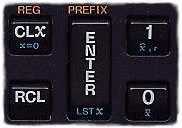What is Reverse Polish Notation?
 When you are at school you learn that different arithmetic operators have
different precedence, although that may not be the exact phrase the teacher
uses. You are probably given a mnemonic such as "My Dear Aunt Sally" (meaning
Multiplication,
Division,
Addition, Subtraction) to tell you the order in which to
do sums. For example, if you are given:
When you are at school you learn that different arithmetic operators have
different precedence, although that may not be the exact phrase the teacher
uses. You are probably given a mnemonic such as "My Dear Aunt Sally" (meaning
Multiplication,
Division,
Addition, Subtraction) to tell you the order in which to
do sums. For example, if you are given:
1 + 2 x 3 = ?
you know to multiply 2 by 3 before adding the 1. Early pocket calculators were not acquainted with Aunt Sally, and would evaluate this expression as 9.
Another school-days mnemonic, BODMAS, tells us to attend to the bracketed expressions first, followed by the usual algebraic operator precedence. Brackets (or more properly parentheses) remove any ambiguity about the order of evaluation of expressions. Most complex expressions could not be expressed without brackets, and they are often used in computer programming even when they are not strictly required, simply to eliminate confusion. For example:
(1+2) x 3 = ?
is guaranteed to evaluate to 9, whatever precedence rules are applied
(or if the programmer has forgotten them).
The BODMAS rule is applied recursively; brackets can contain other
complex expressions which themselves contain brackets, and so on.
In the early days of electronic calculators these rules proved fiendishly difficult to implement in calculator hardware. But calculator designers at Hewlett-Packard realized that a radically different method of defining the arithmetic, invented in the 1920's by Polish mathematician Jan Lukasiewicz (1878-1956) for symbolic logic, could be used to simplify the electronics at the expense of a little learning by the user. In the 1960's that would be regarded as a reasonable trade-off. For most calculator users of the time, the alternative was the error prone practice of writing down intermediate results. The Hewlett-Packard engineers called their calculator logic Reverse Polish Notation (or RPN) in recognition of its inventor.
Using RPN, it is possible to express an arbitrarily complex calculation without using brackets at all. In RPN the simple example above becomes:
3 2 1 + x
This notation may look strange at first, and clearly if the numbers where entered as shown you would get the number three hundred and twenty one! To make a this work you need an extra key that tells the calculator when you have finished entering each number. On most RPN calculators this is called the "Enter" key and fulfils a similar function to an equals key on a conventional calculator but in reverse. So the example would actually be input as:
3 enter 2 enter 1 + x
You need to think of entering numbers as being like putting plates into one of those spring loaded plate stacking trolleys you get in canteens. Every time you enter a number, it is pushed onto the stack. When you eventually start using arithmetic operators, numbers start "popping" off the stack as needed. You can also push more numbers onto the stack. At the end of the calculation you will have "used up" all the numbers and the stack will be empty.
A calculator using conventional logic will internally convert the expression
to the RPN form above. This may be achieved by parsing the bracketed
expression before carrying out the calculation. But more likely the
calculator logic will be pushing numbers down onto the stack every time
a pair of brackets is opened or is implied by the operator precedence.
So in effect an RPN calculator is offloading this work to the calculator
user, resulting in simpler logic design in the calculator. Nowadays
the design issues of using conventional bracket notation in an electronic
calculator are trivial, and yet users of RPN calculators rarely seem to
want to move over to the more conventional algebraic logic. Although
RPN seems strange to the uninitiated, people who overcome the initial hurdle
find it a powerful and elegant tool which is ultimately easier to use.
Luckily for RPN devotees, Hewlett-Packard continues to develop RPN calculators,
such as the HP32 and
some of the latest models have the capability of both RPN and algebraic
logic. And of course Calc98
also supports RPN as a user configurable option.